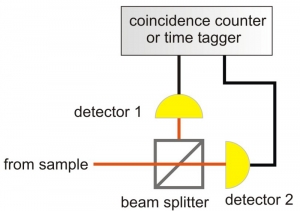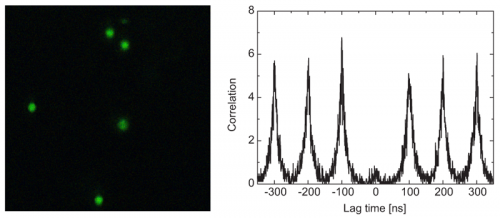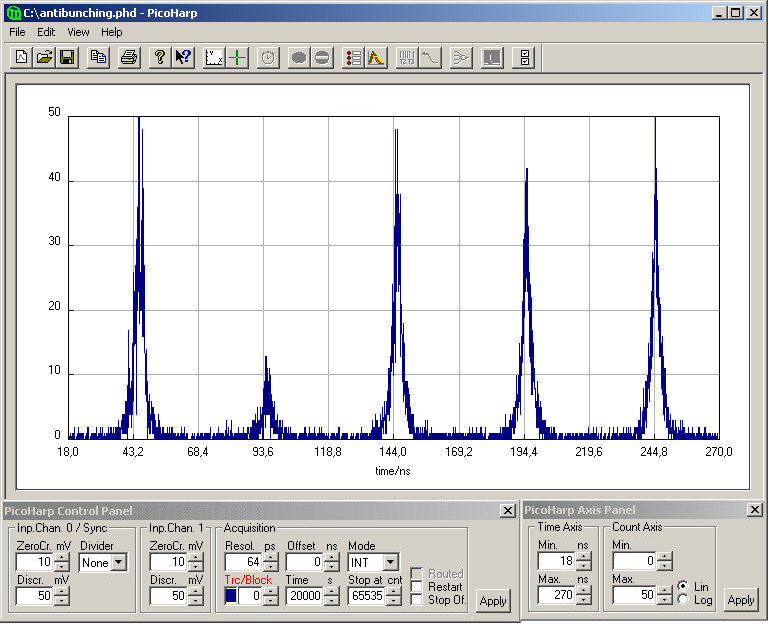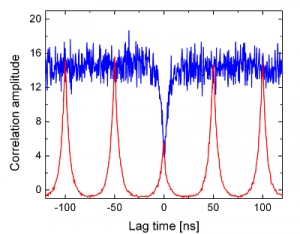 Experiments probing for photon antibunching are usually performed in a Hanbury Brown-Twiss interferometer set-up, in which the emitted light is split with a 50/50 beam-splitter onto two single photon sensitive detectors. The detector outputs are then connected to a TCSPC (Time-Correlated Single Photon Counting) unit and the time difference between the two signals originating from two emitted photons is repeatedly measured and histogrammed with picosecond resolution. The “stop” channel is usually delayed by a certain amount of time in order to visualize also negative correlations. Antibunching experiments can essentially be performed with pulsed or continous-wave excitation. Using continous-wave excitation, the typical result of an antibunching experiment is a flat line with a notable “intensity dip” at a time difference of zero, because a single molecule can not emit two photons at the same time. With pulsed excitation, the result shows the individual laser pulses spaced by the pulse period with a reduced or missing pulse at the correlation time difference of zero. An alternative way to measure antibunching is to time tag the absolute arrival time of all detected photons and then use a dedicated correlation algorithm.
Experiments probing for photon antibunching are usually performed in a Hanbury Brown-Twiss interferometer set-up, in which the emitted light is split with a 50/50 beam-splitter onto two single photon sensitive detectors. The detector outputs are then connected to a TCSPC (Time-Correlated Single Photon Counting) unit and the time difference between the two signals originating from two emitted photons is repeatedly measured and histogrammed with picosecond resolution. The “stop” channel is usually delayed by a certain amount of time in order to visualize also negative correlations. Antibunching experiments can essentially be performed with pulsed or continous-wave excitation. Using continous-wave excitation, the typical result of an antibunching experiment is a flat line with a notable “intensity dip” at a time difference of zero, because a single molecule can not emit two photons at the same time. With pulsed excitation, the result shows the individual laser pulses spaced by the pulse period with a reduced or missing pulse at the correlation time difference of zero. An alternative way to measure antibunching is to time tag the absolute arrival time of all detected photons and then use a dedicated correlation algorithm.
Nitrogen Vacancy (NV) Centers in Diamond
 Luminescent single-nanometer-sized diamond-like carbon particles have received considerable attention in biophysics, material science, nano-medicine, and photonics. Partly this is related to their extraordinary material properties, such as chemical inertness, biocompatibility, and hardness, and also partly due to their exceptional photo stability. All of these applications desire the availability of sub-10 nm particles that show bright and stable photoluminescence. However, it was questionable if very small crystals in the range below 10 nm would still be photostable. To demostrate that a FLIM image was taken that proved the stability since no distortions in the individual crystals due to photobleaching could be seen. The anitbunching trace also shows that indeed there is only a single fluorescent emitter in the nanocrystal investigated.
Luminescent single-nanometer-sized diamond-like carbon particles have received considerable attention in biophysics, material science, nano-medicine, and photonics. Partly this is related to their extraordinary material properties, such as chemical inertness, biocompatibility, and hardness, and also partly due to their exceptional photo stability. All of these applications desire the availability of sub-10 nm particles that show bright and stable photoluminescence. However, it was questionable if very small crystals in the range below 10 nm would still be photostable. To demostrate that a FLIM image was taken that proved the stability since no distortions in the individual crystals due to photobleaching could be seen. The anitbunching trace also shows that indeed there is only a single fluorescent emitter in the nanocrystal investigated.
Set-up:
- MicroTime 200
- Excitation: 532 nm
- Emission: 600-800 nm
- image size: 13 x 13 µm (512 x 512 pixels)
- image: time per pixel: 4.00 ms, total image: 45 min
- antibunching point measurement: 120 s
Sample courtesy of Fedor Jelezko and Jörg Wrachtrup, University of Stuttgart, Germany
Reference: Tisler J., et.al., Nano, Vol.03, p.1959-1965 (2009)
Antibunching of Atto 655

This example shows antibunching measurements of a highly diluted solution of Atto 655 (0.1 nM) in water using pulsed laser excitation. The screenshot shows the results from the antibunching measurements using the standard data acquisition software. The reduced height of the signal peak around 95 ns due to antibunching can clearly be seen.
Set-up:
- MicroTime 200
- Excitation: LDH-P-C-635 at 20 MHz repetition rate
- Detection: two PDM SPADs in a standard Hanbury Brown Twiss (HBT) setup, signal from one detector delayed by approx. 95 ns
- Data acquisition: PicoHarp 300 TCSPC module



 Contact us
Contact us

